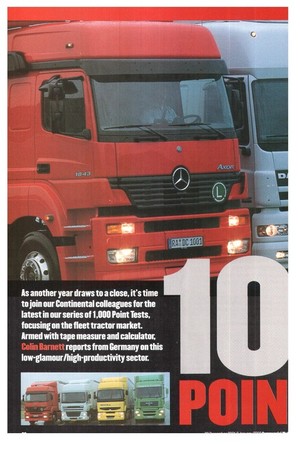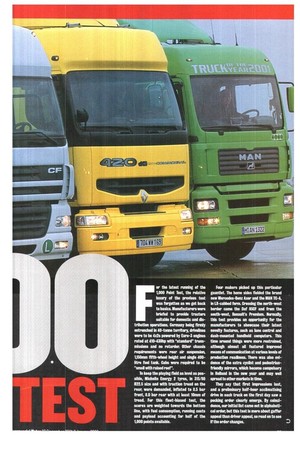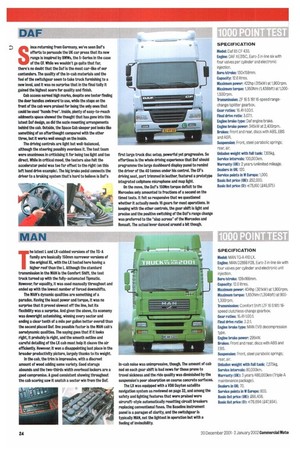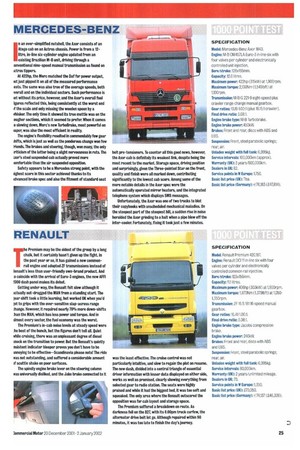As another year draws to a close, it's time to
Page 22

Page 23

Page 24

Page 25

If you've noticed an error in this article please click here to report it so we can fix it.
join our Continental colleagues for the latest in our series of 1,000 Point Tests, focusing on the fleet tractor market. Armed with tape measure and calculator, Colin Barnet reports from Germany on this low-glamour/high-productivity sector. For the latest running of the 1,000 Point Test, the relative luxury of the previous test was forgotten as we got back to basics. Manufacturers were briefed to provide tractors suitable for domestic and distribution operations. Germany being firmly entrenched in 40-tonne territory, drivellnes were to be 4x2s powered by Euro-3 engines rated at 410-430hp with "standard" transmissions and no retarder. Other chassis requirements were rear air suspension, 1,150mm fifth-wheel height and single 401}litre fuel tank. Cabs were required to be "small with raised reef".
To keep the playing field as level as possible, Michelin Energy 2 tyres, in 315/80 R22.5 size and with traction tread on the rear, were demanded, Inflated to 8.5 bar front, 8.0 bar rear with at least 10mm of tread. For this fleet-biased test, the scores are weighted towards the bottom line, with fuel consumption, running costs and payload accounting for half of the 1,000 points available. Four makers picked up this particular gauntlet. The home sides fielded the brand new Mercedes-Benz Axor and the MAN TG-A, in LA-cabbed form. Crossing the north-west border came the Daf B5CF and from the south-west, Renault's Premium. Normally, this test provides an opportunity for the manufacturers to showcase their latest novelty features, such as lane control and dash-mounted handheld computers. This time around things were more restrained, although almost all featured improved means of communication at various levels of production readiness. There was also evidence of the extra cyclist and pedestrianfriendly mirrors, which become compulsory In Holland In the new year and may well spread to other markets In time.
They say that first impressions last, and a preliminary half-hour acclimatising drive in each truck on the first day saw a pecking order clearly emerge. By coinddance, our initial list came out in alphabetical order, but this test is more about gaffer appeal than driver appeal, so read on to see if the order changes. s efforts to persuade the UK car press that its new range is inspired by BMWs, the 5-Series in the case of the CF. While we wouldn't go quite that far, there's no doubt that the Oaf is the most car-like of our contenders. The quality of the in-cab materials and the feel of the swttchgear seem to take truck furnishing to a new level, and it was no surprise that in the final tally it gained the highest score for quality and finish.
Cab access earned high marks, despite one tester finding the door handles awkward to use, while the steps on the front of the cab were praised for being the only ones that could be used "hands free". Inside, plenty of easy-to-reach oddments space showed the thought that has gone Into this latest Oaf design, as did the stele mounting arrangements behind the cab. Outside, the Space Cab sleeper pod looks like something of an afterthought compared with the other three, but it works well enough on the inside.
The driving controls are light but well-balanced, although the steering possibly overdoes It. The test team were unanimous In criticising It for being too light and too direct. While In critical mood, the testers also felt the accelerator pedal was too far offset to the right (on this left hand drive example). The big brake pedal connects the driver to a braking system that's hard to believe is Oaf's
first large truck disc setup, powerful yet progressive. So effortless is the whole driving experience that Oaf should programme the large dashboard display panel to remind the driver of the 40 tonnes under his control. The CF's driving seat, part trimmed in leather, featured a prototype integrated cellphone microphone and map light.
On the move, the Oaf's 150P1m torque deficit to the Mercedes only amounted to fractions of a second on the timed tests. It felt so responsive that we questioned whether it actually needs 16 gears for most operations. In keeping with the other controls, the gear shift is light and precise and the positive switching of the Oaf's range change was preferred to the "slap across" of the Mercedes and Renault. The actual lever danced around a bit though.
he latest L and LX-cabbed versions of the IC-A • family are basically 150mm narrower versions of the original XL, with the LX tested here having a higher roof than the L Although the standard transmission in the MAN is the Comfort Shift, the test truck turned up with the fully-automated Tipmatic. However, for equality, it was used manually throughout and ended up with the lowest number of forced downshifts.
The MAN's dynamic qualities are something of a paradox. Having the least power and torque, it was no surprise that it proved slowest off the line, but its flexibility was a surprise. And given the above, its economy was downright astonishing, winning every sector and ending a clear tenth of a mile per gallon better overall than the second placed Dat One possible factor is the MAN cab's aerodynamic qualities. The saying goes that if it looks right, It probably Is right, and the smooth outline and careful detailing of the LX cab must help It cleave the air efficiently. However, it won a disappointing last place in the broader productivity picture, largely thanks to Its weight.
In the cab, the trim is impressive, with a discreet amount of wood adding some variety. Good storage abounds and the two-thirds width overhead lockers are a good compromise. A good consistent showing throughout the cab scoring saw it snatch a sector win from the Oaf. In-cab noise was unimpressive. though. The amount of cab nod on each gear shift is bad news for those prone to travel sickness and the ride quality was diminished by the suspension's poor absorption on coarse concrete surfaces.
The LX was equipped with a VDO Dayton satellite navigation system as reviewed on page 32, and among the safety and lighting features that were praised were aircraft-style automatically resetting circuit breakers replacing conventional fuses. The Baseline instrument panel is a paragon of clarity, and the switchgear is typically MAN, not the lightest in operation but with a feeling of invincibility.
In an over-simplified nutshell, the Axor consists of an Atego cab on an Actros chassis. Power is from a 12litre, in-line six-cylinder engine updated from an existing Brazilian 14-B unit, driving through a ;onventional nine-speed manual transmission as found on ictros tippers.
At 422hp, the Mere matched the Daf for power output, rut just pipped it on all of the measured performance eats. The same was also true of the average speeds, both iverall and on the individual sectors. Such performance is lot without its price, however, and the Axor's overall fuel igures reflected this, being consistently at the worst end if the scale and only missing the wooden spoon by a vhisker. The only time it showed its true mettle was on the .ougher sections, which it seemed to prefer. When it comes .o slowing down, Merc's new TurboBrake, most powerful on paper, was also the most efficient in reality.
The engine's flexibility resulted in commendably few gear :hifts, which is just as well as the ponderous change won few riends. The brakes and steering, though, won many the only :riticism of the latter being a slight nervousness in ruts. The ixor's steel suspended cab actually proved more :omfortable than the air suspended opposition.
Safety appears to be a Mercedes strong point, with the Ugliest score in this sector achieved thanks to its ithranced brake spec and also the fitment of standard seat belt pre-tensioners. To counter all this good news, however, the Axon cab is definitely its weakest link, despite being the most recent to the market. Storage space, driving position and surprisingly, given the Three-pointed Star on the front, quality and finish were all marked down, contributing significantly to the lowest cab score. Among some of the more notable details in the Axor spec were the automatically operated mirror heaters, and the integrated telephone system which displays SMS messages.
Unfortunately, the bar was one of two trucks to blot their copybooks with unscheduled mechanical maladies. On the steepest part of the steepest hill, a sudden rise in noise heralded the Axor grinding to a halt when a pipe blew off the inter-cooler. Fortunately, fixing it took just a few minutes.
The Premium may be the oldest of the group by a long chalk, but it certainly hasn't given up the fight. In the past year or so, it has gained a new commonrail engine and adopted 2F transmissions instead of lenault's less than user-friendly own-brand product. And a coincide with the arrival of Euro-3 engines, the new AFFI MO dash panel makes its debut.
Getting under way, the Renault felt slow although it ictually out-dragged the MAN from a standing start. The ;ear shift took a little learning, but worked OK when you'd lot to grips with the over-sensitive slap-across range :hange. However, it required nearly 70% more down-shifts :han the MAN, which has less power and torque. And in dmost every sector, the fuel economy was the worst.
The Premium's in-cab noise levels at steady speed were he best of the bunch, but the figures don't tell all. Quiet while cruising, there was an unpleasant degree of diesel mock on the transition to power. But the Renault's quietly nsistent Indicator bleeper proves you don't have to be innoying to be effective—Scandinavia please note! The ride was not outstanding, and suffered a considerable amount if scuttle shake on poor surfaces.
The spindly engine brake lever on the steering column was universally disliked, and the Jake brake connected to it was the least effective. The cruise control was not particularly intuitive, and slow to regain the plot on resume. The new dash, divided into a central triangle of essential driver information with lesser data displayed on either side, works as well as promised, clearly showing everything from selected gear to radio station. The seats were highly praised and while it had the biggest bed, it was too soft and squeaked. The only area where the Renault outscored the opposition was for cab layout and storage space.
The Premium suffered a breakdown en route. As darkness fell on the B27, with its 8.00pm truck curfew, the alternator drive belt let go. Although repaired within 90 minutes, it was too late to finish the day's journey.




























































































































































